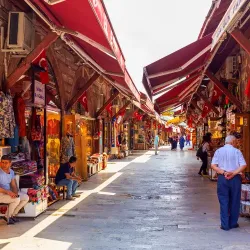European Passage is one of the oldest passages in Istanbul. It was built by the architect Pulgher in the Neo-Renaissance style. It was done with the initiation and support of a merchant called Onnik Düz in 1874 after the Pera fire in 1870. It connects Meşrutiyet Street and Sahne Street, and the length of the European Passage is 56 meters. Its other name is Aynalı Passage, as its upper part is completely covered with mirrors. The first striking detail is the sculptures made of black stone on the right and left sides when you enter. The European Passage, which has a similar structure to 19th-century architecture, immediately attracts the attention of those who want to explore historical bazaars and Istanbul.
Food and entertainment, water structures, bookstores, publishing houses, embassy buildings, religious buildings, educational buildings, cinemas and theaters, historical shops, passage inns, and passages near the historic bazaar. Passages adjacent to the European Passage; Aznavur Passage, Atlas Passage, Anadolu Passage, Çiçek Passage, Alhambra Passage, Aleppo Passage, Hazzopulo Passage, Karlman Passage, Narmanlı Han Passage, Rumeli Passage, Syria Passage, Tunnel Passage Passage are located.
When you enter European Passage, calmly visit all the shops where you can find many shops and buy lovely gifts for your loved ones. There are 22 full shops. The types of shops in the historical bazaar area are rugs, souvenirs, hobby shops, antique shops, Yemeni, postcards, tiles, etc. There are shops like Its lighting was previously made with gas lamps, but it has been changed and modernized today. Its interior attracts the attention of the people passing by. It is one of the places that tourists want to shop in Istanbul.
Also, when you walk on Istiklal Street after shopping at the historical bazaar, you can find historical places, shops, restaurants, and entertainment venues everywhere. Istiklal Street is a small Istanbul. It is where many celebrities, writers, poets, painters, musicians, and actors are frequented and memories.
Other Historical Shops
There are many historical shops for shopping in Istanbul. If we talk a little about them, we can say the following.
-
Butterfly Corset Store: It was opened in 1936. Production and sales are made in the same shop.
-
Madam Katia Hat: Founded in 1944, the store moved to Hazzapulo Passage in 1964.
What to Eat After the European Passage?
Of course, there are fast & food-like food chains and shops near European Passage. But for those looking for historical places, we have a few suggestions.
-
Abdullah Efendi Restaurant: It was built in 1888 at the request of Abdülhamid II. Moved from Karaköy Pier to Beyoğlu.
-
İnci Patisserie: It was built in 1944 by Lefter Iliadis and Luka Zigoris. It is the place that introduces the famous French dessert profiteroles to Turkey.
-
Rejans Russian Restaurant: The most important regular of the restaurant, which was opened in 1932, is Gazi Mustafa Kemal Atatürk.
Consular Buildings
There are numerous consular buildings around the vicinity of European Passage, Istiklal Street. The Consulate General of France, the Consulate General of the Netherlands, the Consulate General of England, the Consulate General of Sweden, and the Consulate General of the Russian Federation are located here. They all are quite pretty to look at and have pleasant architecture.
Religious Buildings
There are a couple of religious and historical buildings around the European Passage. You can carry on your stroll around there.
-
Ağa Mosque: It was built in 1594 by Hüseyin Ağa. It was restored in 2011.
-
Hagia Triada Greek Orthodox Church: Its construction continued from 1867 to 1880. Vasilaki Ioannidis undertook the construction.
-
Galatasaray Panayia Church: It was built in 1804. It was made with the permission of the Ottoman administration of the day.
-
Saint Antoine Catholic Church: It was built between 1906 and 1912. Its architect is Giulio Monger. It has beautiful architecture with its redbrick structure.
-
Santa Maria Draperies Church: Although it was built in 1768, the construction phase dates back to 1585. In the 1660s, a fire broke out, and the church was destroyed. The Austro-Hungarian embassy then undertakes the rebuilding of the burned-out church.
Art and Culture
-
Atlas Cinema: Founded in 1948, the cinema has survived to the present day.
-
Atatürk Cultural Center: The building, whose short name is AKM, was opened for the third time with its renewed building on October 29, 2021, and met with art lovers.
How to go to Istanbul Beyoglu, European Passage?
The buses you can take to come here are quite simple. All the buses that go to Taksim will get you close enough. After reaching Taksim, you can have a short walk there. The buses are 36T, 46C, 54E, 66, 74A, and 97T.
You can use the M2 metro, and the same as busses, take off at Taksim or Şişhane stop and walk there. Enjoy the beautiful Istiklal Street on the way
Frequently Asked Question
Why is Istanbul an important city?
Istanbul is a metropolis whose history that spans generations, and it is a city that witnessed the rise and fall of empires.
What is the old name of Istanbul?
Constantinople.
What is special about Istanbul?
Istanbul, situated between Asia and Europe, contains both oriental and western cultural elements.
Who built Istanbul?
Constantine build it in 330 AD.
What is the capital of Turkey?
Even though the cultural capital is Istanbul, the political capital is Ankara.
 Macedonian
Macedonian  Indonesian
Indonesian  Urdu
Urdu  Taiwanese
Taiwanese  Russian
Russian  Romanian
Romanian  Portuguese
Portuguese  Persian
Persian  Korean
Korean  Japanese
Japanese  Italian
Italian  Indian
Indian  Hungarian
Hungarian  Greek
Greek  German
German  Croatian
Croatian  Chinese
Chinese  Bulgarian
Bulgarian  Arabic
Arabic  French
French  Spanish
Spanish  English
English 



